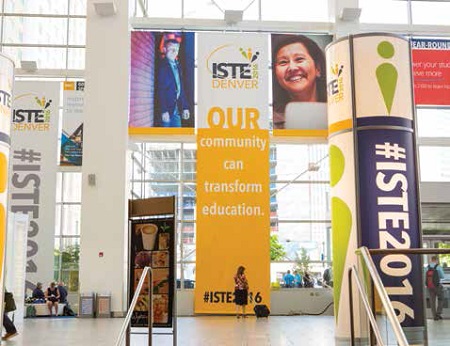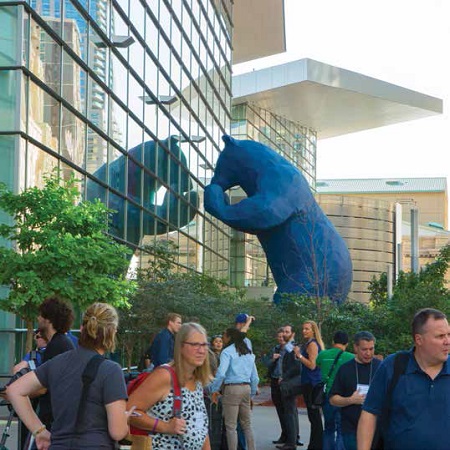THE ISTE ISSUE

ISTE TAKEAWAYS
The ISTE Blues
By Jon Castelhano
It’s easy to be overwhelmed by the ISTE data overload, between the content-filled sessions, the keynotes, the poster and playground spaces, and the endless conversations. Here are a few tips to help ensure you keep the learning going after the conference is over:

From the Middle: It doesn’t matter what your role is in your organization—you’ve just spent four days gathering content that you need to share. Take the “lead from the middle” approach and decide how you can share what you’ve learned with your peers, administration, technology staff, and any others who could benefit. This could also be an opportunity to use a new medium to share information. Try using a presentation platform, blog site, or creative new app that you experienced at the conference.
Stay in Touch: I’ve said a number of times that the best place to make connections at ISTE is standing in line waiting to purchase that delightful iced coffee or refreshing bottle of water. I do suggest we change the phrase “standing in line” to “standing in the PLN line,” because that’s where we end up exchanging email addresses, Twitter and Instagram handles, and district names for future collaboration with educators from around the globe. Now that you have these new contacts, don’t hesitate to reach out and continue the conversations and sharing of ideas that you started while waiting in that PLN line.
Bring ISTE Home: Every year ISTE creates a magical coming together of 15,000 like-minded educators. Many ISTE members may not be aware, however, that ISTE affiliate groups exist in virtually every state, and that there are international affiliates in Australia, Canada, Europe, India, the Philippines, and the United Kingdom as well. These affiliate groups are all a bit different and offer a variety of benefits and professional development opportunities throughout the year. Membership in a local affiliate provides further opportunities to continue to grow your PLN, attend events in your state, and become involved with advocacy movements that can directly affect your classroom and students. To find an affiliate in your area, check out the affiliate directory (http://www.iste.org/getinvolved/affiliate-directory) and continue making connections!
Tools and ideas to transform education. Sign up below.
Council of Elders
By Chris Lehmann
This was my tenth ISTE. There’s something incredible about going back, year after year, to a community that has watched me grow up professionally and has watched the Science Leadership Academy grow from a scrappy little start-up to what it is now—three schools and a non-profit working to spread inquiry-based education to a wider array of schools. And what struck me this year is how many people in this community have become, over time, a big part of my council of elders.
A council of elders doesn’t necessarily have to be composed of people who are older than you are, but they are the ones whose perspectives and wisdom can push your thinking in important ways. They are also the folks you trust. You know they won’t just tell you what you want to hear or allow their words to be colored by their own interests in what you’re doing. Your council of elders consists of those whose lived experiences have given them a window into your life and your challenges. And, through them, you’re able to see yourself through a different lens.
I think every leader needs her council of elders. In the end, having a council of elders is nothing more nor less than the collaborative part of reflection. It’s about carving out the time to reflect and remembering to have the humility to know that, sometimes, we need others to hold the mirrors up for us.
I was reminded this week of how powerful my council of elders is, and how important these people are to me. Thanks, ISTE, for bringing together so many amazing colleagues. And I have new marching orders for this coming year: to remember to check in more often with lots of different folks.
And, of course, I’ve got to remember to pay it forward. I need to remind the folks to whom I’ve said, “Call me if you need me,” that I meant it, too.
Face Off: Should Teachers Pay Teachers Or Share Freely?
By Lisa Nielsen
Amazon Education One of the big news announcements at #ISTE2016 was the launch of @AmazonEdu’s Inspire, a new marketplace of free materials that will include tens of thousands of lesson plans, worksheets, and other instructional materials just in time for the back-to-school season this August.

But what does this mean for the more than two million teachers who are already paying other teachers for this type of content on the popular Teachers Pay Teachers Web site where teachers earn money for the materials they’ve created for the classroom?
According to Tom Whitby and Steve Anderson, authors of The Relevant Educator, Amazon Inspire is on the right track. In their recent talk at #ISTE2016 they said they believe that relevant educators don’t pay each other but share with each other freely.
On the other side of the debate are educators like Angela Maiers and Vicki Davis. They believe that when teachers are compensated, they’re motivated to create materials that surpass the quality of anything processed by the textbook industry muddle machine. Angela and Vicki explain that when teachers enter the freelance marketplace, they work on their own time to transform what they use for the classroom into quality materials with instructions that can be used in the world.
So, what do you think?
Should educators pay each other or share their genius freely?
The ISTE Experience
By Carl Hooker
As I walked the halls of ISTE 2016, I asked people about their experience of an event of this magnitude. “Overwhelming,” “exciting,” “exhausting,” and “inspiring” are some of the words I heard most often from those I talked with among the more than 18,000 attendees.

I can’t say that I disagree with any of those quotes. As someone presenting multiple sessions, I know that switching from learner to teacher can be exhausting. But it’s also exciting. One follow-up question I try to ask attendees is: “What’s something you’ll take away and use in your classroom?” Too often, at big events like this we’re inspired by ideas but don’t take the time to sit and reflect, to think about how we’ll integrate all the thoughts and ideas flowing through these rooms in Denver.
One of the biggest takeaways for me is that the coding movement is real. In sessions, in the exhibit hall, and in the keynote addresses, it was clear that we’ve definitely surpassed the “hour of code” in schools. The next challenge is integrating it into everyday curriculum.
I attend ISTE every year and am excited for what the future will bring. I really hope this coding movement isn’t just a trend, but rather a foreign language in schools for the future.
